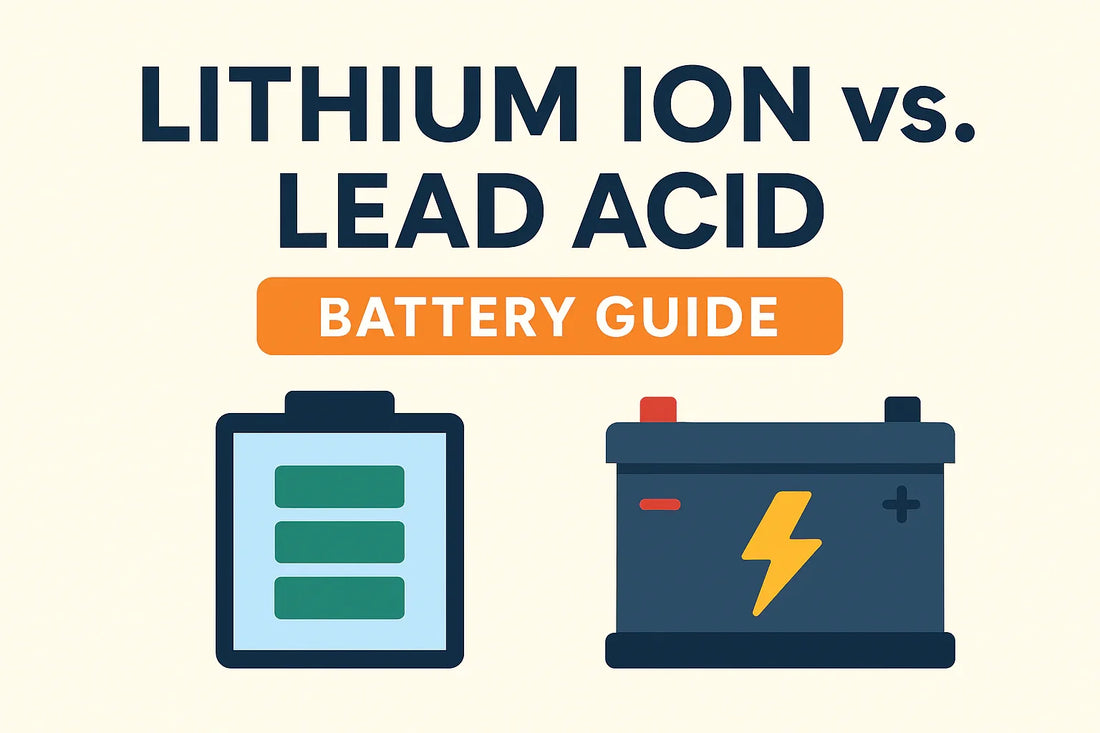
Lithium Ion vs. Lead Acid Batteries: Battery Guide
Share
Lithium Ion vs. Lead Acid Batteries: A Complete Guide to Battery Options
In the evolving world of energy storage, understanding the differences between lithium-ion and lead-acid batteries is crucial. These two battery types are pivotal in numerous applications, ranging from renewable energy systems to electric vehicles. As technology advances, battery options expand, offering diverse solutions for varied requirements. This guide delves into the key aspects of lithium-ion vs. lead-acid options, highlighting their unique features and benefits.
Introduction to Batteries
Batteries are essential components in modern technology, serving as energy storage devices that power everything from small gadgets to large industrial systems. They convert chemical energy into electrical energy, facilitating portable power solutions. The evolution of battery technology has led to a wide array of battery options, each suited to specific applications. Understanding these options helps in selecting the right battery for your energy needs.
What is a Battery?
A battery is a device that stores energy in chemical form and converts it into electricity when needed. It is composed of one or more cells, each containing a positive and negative electrode separated by an electrolyte. Batteries typically supply power for various applications, from small electronics to large-scale energy systems. The cycle life and depth of discharge are critical factors influencing a battery's performance and longevity.
Types of Batteries
Batteries come in several types, each with distinct chemistries and characteristics. Below is a comparison of two common types:
| Type | Characteristics |
|---|---|
| Lead-acid batteries | Reliability and affordability; includes sealed lead acid (SLA) variants like Absorbent Glass Mat (AGM) and Gel |
| Lithium-ion batteries | Advanced technology with chemistries such as Lithium Iron Phosphate (LiFePO4), Lithium Nickel Manganese Cobalt Oxide (NMC); LiFePO4 batteries are favored in solar applications for safety and efficiency |
Importance of Battery Selection
Selecting the appropriate battery type is crucial for optimizing performance and reducing the cost of ownership. The right choice can significantly enhance productivity and the overall efficiency of a battery system. Lead-acid and lithium-ion batteries each have their advantages, and understanding the specifics of battery chemistries can guide you in making an informed decision. A battery management system can further improve performance by monitoring and regulating energy use.
Understanding Lead Acid Batteries
How Lead Acid Batteries Work
Lead acid batteries are a cornerstone in the realm of rechargeable power sources, utilizing lead and sulfuric acid to generate electricity. At their core, these batteries operate through a chemical reaction where lead plates are immersed in sulfuric acid. This immersion prompts the sulfate ions from the sulfuric acid to bond with the lead, creating an electric charge. When recharging, the reaction is reversed, allowing the sulfate to return to the acid, thus restoring the battery's energy. It's important to manage the depth of discharge carefully, as these batteries should only be used to 50% of their capacity to maintain their cycle life and ensure optimal performance.
Advantages of Lead Acid Batteries
Lead acid batteries are favored for their cost-effectiveness, presenting a lower upfront cost compared to lithium-ion batteries. This affordability extends to their production process, making them easier and more economical to manufacture. As a popular choice for many applications, they provide a dependable energy storage solution. While they may not offer the same advanced technology as lithium batteries, their affordability and reliability make them a valuable option in situations where cost is a primary concern.
Disadvantages of Lead Acid Batteries
Despite their advantages, lead acid batteries have notable drawbacks, including a shorter lifespan and the necessity for regular maintenance. To avoid compromising their longevity, it's crucial not to exceed a 50% depth of discharge. In colder temperatures, these batteries suffer a decline in efficiency and usable capacity, delivering only 70 to 80 percent of their rated capacity at 32°F. Additionally, they have a narrow range of suitable charging conditions, often requiring a float charge in standby applications. Compared to lithium-ion batteries, lead acid variants charge more slowly, often necessitating spare SLA batteries in cyclic applications to maintain continuous power availability.
Exploring Lithium-Ion Batteries
How Lithium Ion Batteries Work
Lithium-ion batteries operate through a sophisticated chemical process compared to lead acid batteries. They comprise six primary components:
| Component | Function |
|---|---|
| Anode | Stores lithium, generates free electrons, creates a charge at the positive current collector |
| Cathode | Stores lithium |
| Separator | Ensures safety by preventing contact between anode and cathode |
| Electrolyte | Facilitates the movement of lithium ions between anode and cathode |
| Negative and Positive Current Collectors | Conduct electrons to and from the battery terminals |
As the battery discharges, lithium ions create a flow of electrons that power devices, and the process reverses during charging.
Advantages of Lithium-Ion Batteries
Lithium-ion batteries are celebrated for their maintenance-free nature and extended lifespan, despite their higher initial cost. They outperform lead-acid batteries by lasting up to ten times longer. With a cycle life of up to 3,500 cycles at 80% discharge, they offer remarkable longevity. Even in cold temperatures, they maintain 95-98% capacity efficiency, warming up during use to improve performance. Their rapid charging, high efficiency, and consistent power delivery make them superior to lead-acid alternatives in many applications.
Disadvantages of Lithium-Ion Batteries
Despite their numerous advantages, the upfront cost of lithium-ion batteries is significantly higher than that of lead-acid batteries. This initial expense can be a barrier for individuals or organizations with limited budgets, although the long-term savings in maintenance and replacement costs often justify the investment. Additionally, specific applications might not require the extensive capabilities of lithium-ion technology, making the cost less justifiable in those scenarios.
Lead Acid Battery vs Lithium Ion Battery
Performance Comparison
In terms of performance, lithium-ion batteries significantly surpass lead-acid counterparts. Here is a comparison:
| Feature | Lithium-ion Batteries | Lead-acid Batteries |
|---|---|---|
| Cycle Life (80% discharge) | Approximately 3,500 cycles | 300-500 cycles |
| Energy Density (Wh/L) | Around 450 | 80-90 |
| Efficiency | About 95% | 50% |
Consequently, lithium-ion batteries provide more energy storage and efficiency.
Cost Analysis
While lithium-ion batteries are more expensive initially, their longer lifespan and reduced maintenance needs make them more cost-effective over time. A single lithium battery can outlast ten lead-acid batteries, significantly decreasing the cost of ownership. Despite the higher upfront expense, the investment in lithium-ion technology provides greater value, especially when considering the extended cycle life and reduced frequency of replacements.
Applications and Use Cases
For those living off-grid, lithium options are ideal for heavy use due to their longevity and efficiency, while FLA batteries may suffice if regular maintenance is not an issue. In less frequently used settings, such as vacation homes, SLA batteries are recommended. For remote industrial applications, both sealed lead-acid and lithium options are suitable. The choice of battery type depends on specific energy needs, usage frequency, and maintenance preferences.
Battery Storage Considerations
Optimal Conditions for Battery Storage
When considering optimal conditions for battery storage, understanding the requirements of different battery types is crucial. Lithium-ion batteries should not be stored at 100% State of Charge (SOC) to prevent degradation over time. Instead, maintaining them at around 40-60% SOC is ideal for preserving their cycle life. In contrast, sealed lead-acid (SLA) batteries need to be stored at full charge. Many users employ a trickle charger to keep SLA batteries at 100%, ensuring the battery energy storage remains efficient and preventing a decrease in battery capacity during periods of inactivity.
Maintenance Tips for Longevity
Proper maintenance is vital for extending the lifespan of batteries, especially for lead-acid types. Flooded lead-acid (FLA) batteries must be checked regularly and refilled every 1-3 months to ensure optimal performance. Neglecting this upkeep can significantly shorten their cycle life and may even void warranties. On the other hand, lithium batteries, including lithium iron phosphate variants, are largely maintenance-free, offering convenience and longevity. However, integrating a battery management system can enhance their efficiency and lifespan by monitoring and optimizing battery energy usage.
Environmental Impact of Battery Disposal
The environmental impact of battery disposal is a significant consideration in battery technology. Lead-acid batteries are largely recyclable, with over 95% of their components being reused, reducing their environmental footprint. However, improper disposal can lead to soil and water contamination. Lithium-ion batteries, while less toxic, pose challenges due to their complex chemistries, making recycling more difficult. Advancements in recycling processes aim to improve the sustainability of both battery types, ensuring a more environmentally friendly approach to battery energy storage and disposal.
Conclusion
Final Thoughts on Battery Choices
When choosing between lead acid and lithium-ion batteries, a common question is whether lithium batteries justify their higher cost. The decision should be guided by specific needs and usage patterns. Lithium-ion batteries, with their longer cycle life and minimal maintenance, may provide greater value in high-demand scenarios. Conversely, lead-acid batteries offer a cost-effective solution for applications requiring less frequent energy storage. Each type of battery has its place, depending on the balance between upfront cost and long-term benefits.
Future Trends in Battery Technology
Future trends in battery technology predict significant growth for lithium-ion solutions. The global lithium-ion battery market is expected to expand by over 12% between 2021 and 2030, driven by advancements in electric vehicles and renewable energy storage. In contrast, the lead-acid battery market is projected to grow by about 5% in the same period. This trend highlights a shift towards more efficient and sustainable battery chemistries, promising improved battery energy storage solutions for various applications.
Resources for Further Reading
For those interested in delving deeper into the subject of battery technology, numerous resources are available. Scholarly articles, industry reports, and online courses offer comprehensive insights into the latest advancements and trends in battery chemistries and energy storage solutions. Exploring these resources can provide a more complete guide to understanding the complexities and potentials of lithium vs. lead acid batteries, helping users make informed decisions about their energy storage needs.
